最新小学英语四种时态总结
小学英语四种时态总结
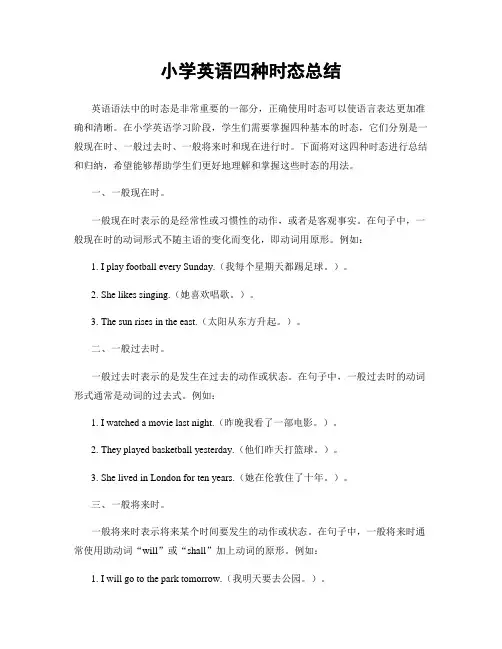
小学英语四种时态总结英语语法中的时态是非常重要的一部分,正确使用时态可以使语言表达更加准确和清晰。
在小学英语学习阶段,学生们需要掌握四种基本的时态,它们分别是一般现在时、一般过去时、一般将来时和现在进行时。
下面将对这四种时态进行总结和归纳,希望能够帮助学生们更好地理解和掌握这些时态的用法。
一、一般现在时。
一般现在时表示的是经常性或习惯性的动作,或者是客观事实。
在句子中,一般现在时的动词形式不随主语的变化而变化,即动词用原形。
例如:1. I play football every Sunday.(我每个星期天都踢足球。
)。
2. She likes singing.(她喜欢唱歌。
)。
3. The sun rises in the east.(太阳从东方升起。
)。
二、一般过去时。
一般过去时表示的是发生在过去的动作或状态。
在句子中,一般过去时的动词形式通常是动词的过去式。
例如:1. I watched a movie last night.(昨晚我看了一部电影。
)。
2. They played basketball yesterday.(他们昨天打篮球。
)。
3. She lived in London for ten years.(她在伦敦住了十年。
)。
三、一般将来时。
一般将来时表示将来某个时间要发生的动作或状态。
在句子中,一般将来时通常使用助动词“will”或“shall”加上动词的原形。
例如:1. I will go to the park tomorrow.(我明天要去公园。
)。
2. She shall visit her grandparents next week.(她下周要去看望她的祖父母。
)。
3. We will have a party on Friday.(我们星期五要举办派对。
)。
四、现在进行时。
现在进行时表示现在正在进行的动作,或者是现阶段正在发生的动作。
在句子中,现在进行时的动词形式是“be”动词的现在分词形式。
小学英语四大时态总结
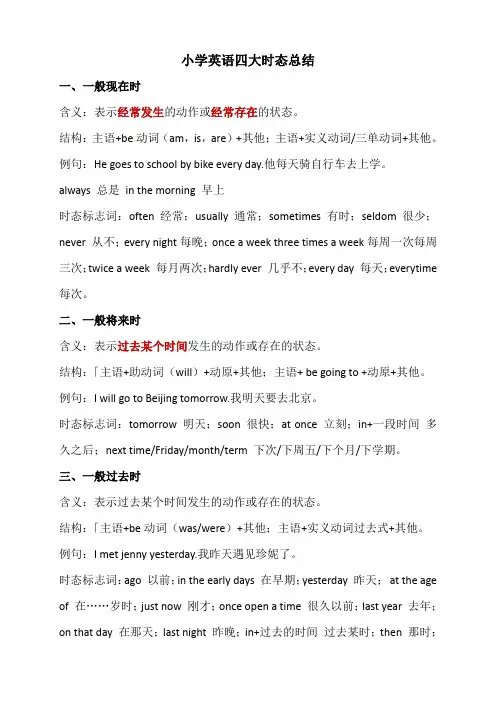
小学英语四大时态总结一、一般现在时含义:表示经常发生的动作或经常存在的状态。
结构:主语+be动词(am,is,are)+其他;主语+实义动词/三单动词+其他。
例句:He goes to school by bike every day.他每天骑自行车去上学。
always 总是in the morning 早上时态标志词:often 经常;usually 通常;sometimes 有时;seldom 很少;never 从不;every night每晚;once a week three times a week每周一次每周三次;twice a week 每月两次;hardly ever 几乎不;every day 每天;everytime 每次。
二、一般将来时含义:表示过去某个时间发生的动作或存在的状态。
结构:「主语+助动词(will)+动原+其他;主语+ be going to +动原+其他。
例句:I will go to Beijing tomorrow.我明天要去北京。
时态标志词:tomorrow 明天;soon 很快;at once 立刻;in+一段时间多久之后;next time/Friday/month/term 下次/下周五/下个月/下学期。
三、一般过去时含义:表示过去某个时间发生的动作或存在的状态。
结构:「主语+be动词(was/were)+其他;主语+实义动词过去式+其他。
例句:I met jenny yesterday.我昨天遇见珍妮了。
时态标志词:ago 以前;in the early days 在早期;yesterday 昨天;at the age of 在……岁时;just now 刚才;once open a time 很久以前;last year 去年;on that day 在那天;last night 昨晚;in+过去的时间过去某时;then 那时;the day before yesterday 前天;one day 一天last week/month/term 上周/上个月/上学期。
小学英语四种时态整理
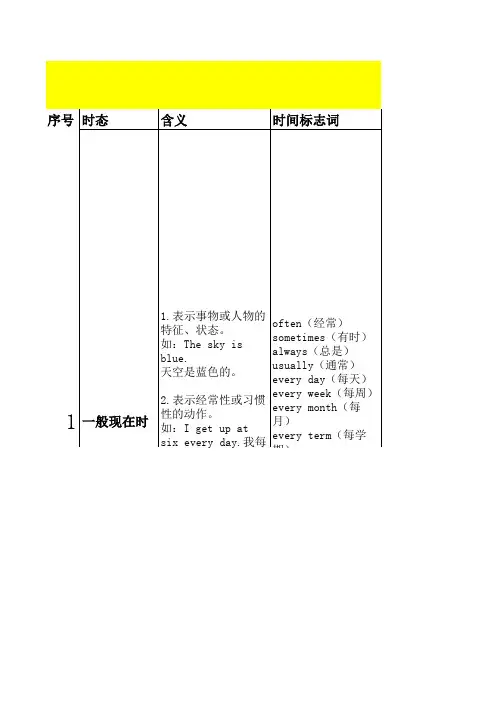
动词变化规则
Be动词口诀:我用am你用are,is连着 她他它,单数is复数are,要想学好牢 记他。变否定更容易。be后not莫忘 记,变疑问,往前提,句尾问好莫丢弃 。什么问什么答,你问我答
动词+s的变化规则(动词三单)
1.直接加s,
如:cook-cooks, milk-milks
2.以s. x. sh. ch. o结尾 ,
妖镜,后面动词现原形)
be + doing
一般疑问句:Be提前 变否定就:Be 后+not is not= isn't are not=aren't I am not =I'm not
be 动词: Be(was/were)+其他
was/were is/am-was are-were was not=wasn't were not=weren't
陈述句: We will go to Beijing tomorrow. 否定句: We won't go to Beijing tomorrow. 一般疑问句及其答语: Will you go to Beijing tomorrow ? Yes,she will../No,she won't.
be找助动词。
一般疑问句:Do 在前 非三单,动词为原形 Do+主语+动词原形+其它 ?
变否定就:动词前+don't
实义动词: 主语+实义动词(+其 它)
实义动词: 主语+实义动词(+其 它)
一般疑问句:Does在前
主语为第三人称单数 (he, she,it)时,要 在动词后加"-s"或"es"。
小学英语四种时态总结
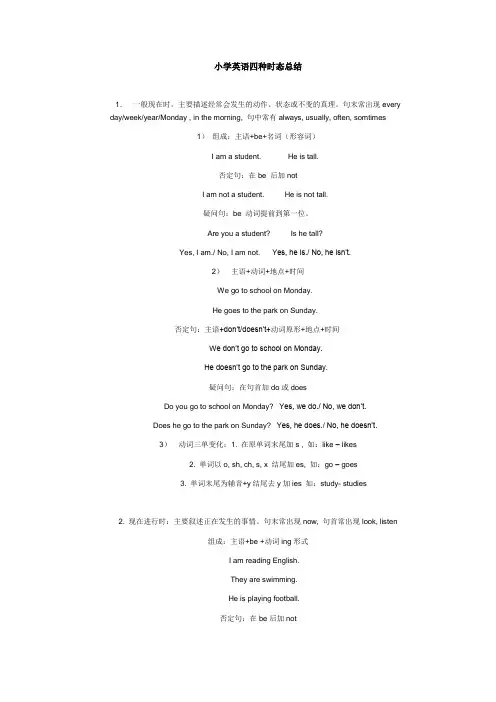
小学英语四种时态总结1.一般现在时。
主要描述经常会发生的动作、状态或不变的真理。
句末常出现every day/week/year/Monday , in the morning, 句中常有always, usually, often, somtimes1)组成:主语+be+名词(形容词)I am a student. He is tall.否定句:在be 后加notI am not a student. He is not tall.疑问句:be 动词提前到第一位。
Are you a student? Is he tall?Yes, I am./ No, I am not. Yes, he is./ No, he isn’t.2)主语+动词+地点+时间We go to school on Monday.He goes to the park on Sunday.否定句:主语+don’t/doesn’t+动词原形+地点+时间W e don’t go to school on Monday.He doesn’t go to the park on Sunday.疑问句:在句首加do或doesDo you go to school on Monday? Yes, we do./ No, we don’t.Does he go to the park on Sunday? Yes, he does./ No, he doesn’t.3)动词三单变化:1. 在原单词末尾加s , 如:like – likes2. 单词以o, sh, ch, s, x 结尾加es, 如:go – goes3. 单词末尾为辅音+y结尾去y加ies 如:study- studies2. 现在进行时:主要叙述正在发生的事情。
句末常出现now, 句首常出现look, listen组成:主语+be +动词ing形式I am reading English.They are swimming.He is playing football.否定句:在be后加notI am not reading English.They are not swimming.He is not playing football.疑问句:将be 放到第一位。
小学四种英语时态的归纳总结

千里之行,始于足下。
小学四种英语时态的归纳总结小学英语时态的归纳总结在小学阶段学习英语,掌握四种基本的时态是非常重要的。
这四种时态分别是一般现在时、一般过去时、一般将来时和现在进行时。
以下是对这四种时态的归纳总结。
一、一般现在时(Simple Present Tense)1. 表示经常性的动作或状态。
例如:I play basketball every Saturday.2. 在陈述句中,主语和动词要一致。
例如:He likes to watch movies.3. 在否定句中,用do / does + not + 动词原形。
例如:She does not like vegetables.4. 在疑问句中,用do / does + 主语 + 动词原形?例如:Do you have any pets?5. 用于表示客观事实、经验等。
二、一般过去时(Simple Past Tense)1. 表示过去发生的动作或状态。
例如:I watched a movie yesterday.2. 在陈述句中,动词过去式的变化规则是直接加-ed。
例如:We played soccer last week.3. 在否定句中,用did + not + 动词原形。
例如:She did not go to school yesterday.4. 在疑问句中,用did + 主语 + 动词原形?例如:Did you finishyour homework?第1页/共3页锲而不舍,金石可镂。
三、一般将来时(Simple Future Tense)1. 表示将来发生的动作或状态。
例如:I will go to the park tomorrow.2. 在陈述句中,用will / shall + 动词原形。
例如:She will visither grandparents next week.3. 在否定句中,用will not / won't + 动词原形。
最新小学英语4种时态总结
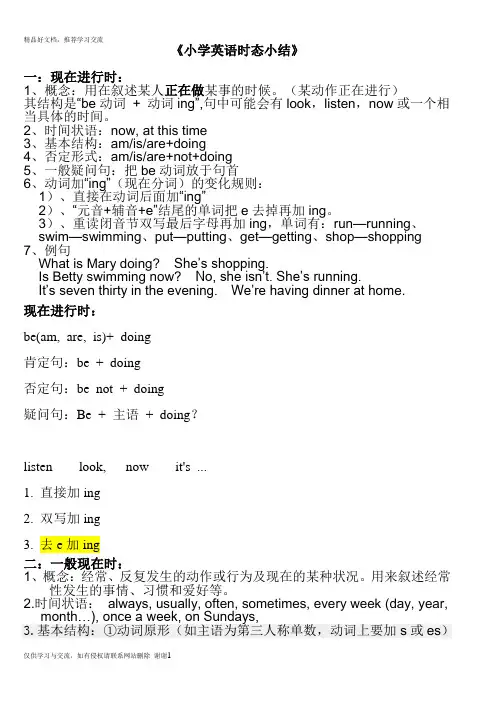
《小学英语时态小结》一:现在进行时:1、概念:用在叙述某人正在做某事的时候。
(某动作正在进行)其结构是“be动词+ 动词ing”,句中可能会有look,listen,now或一个相当具体的时间。
2、时间状语:now, at this time3、基本结构:am/is/are+doing4、否定形式:am/is/are+not+doing5、一般疑问句:把be动词放于句首6、动词加“ing”(现在分词)的变化规则:1)、直接在动词后面加“ing”2)、“元音+辅音+e”结尾的单词把e去掉再加ing。
3)、重读闭音节双写最后字母再加ing,单词有:run—running、swim—swimming、put—putting、get—getting、shop—shopping7、例句What is Mary doing? She’s shopping.Is Betty swimming now? No, she isn’t. She’s running.It’s seven thirty in the evening.We’re having dinner at hom e.现在进行时:be(am, are, is)+ doing肯定句:be + doing否定句:be not + doing疑问句:Be + 主语+ doing?listen look, now it's ...1. 直接加ing2. 双写加ing3. 去e加ing二:一般现在时:1、概念:经常、反复发生的动作或行为及现在的某种状况。
用来叙述经常性发生的事情、习惯和爱好等。
2.时间状语:always, usually, often, sometimes, every week (day, year,month…), once a week, on Sundays,3.基本结构:①动词原形(如主语为第三人称单数,动词上要加s或es)4.否定形式:①此时态的谓语动词若为行为动词,则在其前加don't,如主语为第三人称单数,则用doesn't,同时还原行为动词; ②am/is/are+not。
小学英语四种时态总结
四种时态总结一、一般现在时标志词:always(总是) usually(通常) often(经常) sometimes(有时) never(从不) every(每一)一般现在时基本用法:功能1.表示事物或人物的特征、状态。
如:The sky is blue.天空是蓝色的。
2.表示经常性或习惯性的动作。
如:I get up at six every day.我每天六点起床。
3.表示客观现实。
如:The earth goes around the sun.地球绕着太阳转。
The earth is round.构成1. be动词:主语+be(am,is,are)+其它。
如:I am a boy.我是一个男孩。
2.行为动词:主语+行为动词(+其它)。
如:We study English.我们学习英语。
※当主语是第三人称单数时,一般动词在一般现在时句子中的变化规律:(单三)1、多数在动词后加s play—plays like—likes ,2、以s,x,sh,ch,o结尾的动词加es wash–washes catch–catches do–does3、以辅音字母加y结尾,把y改i再加es fly—flies study—studies4、以元音字母加y结尾,直接加s buy – buys5、不规则变化have—has二.现在进行时现在进行时:表示正在进行的、发生的动作标志词:now, look, listen,It’s+时间基本结构:ambe is + 动词ing 例:I am watching TV.are现在分词动词的-ing形式的变化规律:1. 直接加-ing watch—watching clean—cleaning2. 以-y结尾的动词,直接加-ing study—studying play—playing3. 以不发音的-e结尾的动词,先去-e再加-ing make—making come—coming4. 末尾只有一个元音字母和一个辅音字母的重读闭音节动词,双写末尾字母,再加-ingcut—cutting 切put-- putting 放swim -- swimming 游泳run -- running 跑get -- getting 得到let -- letting 让hit -- hitting 打,击,撞begin -- beginning 开始sit -- sitting 坐 win --winning 赢shop --shopping 购物stop -- stopping 停止plan -- planning 计划 forget -- forgetting 忘记step -- stepping 踩,踏set -- setting 设置三、一般将来时表示将来某一时刻的动作或状态,或将来某一段时间内经常的动作或状态。
小学的四大时态知识点总结
小学的四大时态知识点总结时态是英语中非常重要的一部分,它指明动作或状态发生的时间。
在英语中,有四个基本的时态:一般现在时、一般过去时、一般将来时和现在进行时。
这篇文章将对这四大时态知识点进行总结,帮助小学生更好地理解和掌握它们。
一、一般现在时1.1 表示习惯性或经常性的动作或状态一般现在时用来表示经常性或习惯性的动作或状态。
例如:I go to school every day.(我每天去学校。
)1.2 表示客观真理或普遍事实一般现在时也用来表示客观真理或普遍事实。
例如:Water boils at 100 degrees Celsius.(水在100摄氏度时煮沸。
)1.3 表示现在的情况或状态一般现在时还可以用来表示当前的情况或状态。
例如:She looks very happy today.(她今天看上去很开心。
)二、一般过去时2.1 表示过去发生的动作或状态一般过去时用来表示过去发生的动作或状态。
例如:They played basketball yesterday.(他们昨天打篮球。
)2.2 表示过去的习惯或经常性动作一般过去时还可以表示过去的习惯或经常性动作。
例如:I always watched TV after school when I was young.(我小的时候放学后经常看电视。
)2.3 表示过去的客观真理或普遍事实一般过去时也可以用来表示过去的客观真理或普遍事实。
例如:People believed the earth was flat in ancient times.(古代人相信地球是扁的。
)三、一般将来时3.1 表示将来要发生的动作或状态一般将来时用来表示将来要发生的动作或状态。
例如:I will go to the park tomorrow.(我明天会去公园。
)3.2 表示对将来的预测或打算一般将来时还可以表示对将来的预测或打算。
例如:I think it will rain this afternoon.(我觉得今天下午会下雨。
小学的四大时态知识点总结
小学的四大时态知识点总结小学英语教学中,时态是学生必须掌握的基本语法点之一。
以下是小学阶段学生需要掌握的四大时态知识点的总结:1. 一般现在时(Simple Present Tense)- 用法:表示经常发生的动作或状态,或者表示客观事实。
- 结构:主语 + 动词原形/动词的第三人称单数形式(如:He/She/It + 动词-s/-es)。
- 例句:She goes to school every day.(她每天去上学。
)2. 现在进行时(Present Continuous Tense)- 用法:表示正在进行或发生的动作。
- 结构:主语 + be动词(am/is/are)+ 动词的现在分词形式(-ing)。
- 例句:They are playing football now.(他们现在正在踢足球。
)3. 一般过去时(Simple Past Tense)- 用法:表示过去发生的动作或状态。
- 结构:主语 + 动词的过去式。
- 例句:He visited his grandparents last week.(他上周拜访了他的祖父母。
)4. 一般将来时(Simple Future Tense)- 用法:表示将来发生的动作或状态。
- 结构:主语 + will + 动词原形;或主语 + be going to + 动词原形。
- 例句:She will go to the library tomorrow.(她明天将去图书馆。
)掌握这些基本时态对于小学生来说至关重要,它们是构建句子和表达思想的基础。
在学习过程中,学生应该通过大量的练习和实际应用来加深对这些时态的理解和运用。
同时,老师和家长也应该鼓励学生在日常生活中使用英语,以提高他们的语言能力。
通过不断的练习和应用,学生将能够更加熟练地掌握这些时态,并在英语交流中更加自信。
小学英语四种时态总结
1.现在进行时①标志词---- now, listen, look,表示正在发生的事情或进行的动作。
②结构:1.人/物+ 2. be动词(am, is, are) + 3.动词ing. eg:He is running now.Look! It is snowing. Sam is swimming. Tom is playing table tennis.Listen! Amy and lingling are singing and dancing in the park.③一般疑问句将be动词提前,否定句在be动词后+not. eg: Is he running now? / He is not(He isn’t) running now.Are they playing football now? / They are not (They aren’t )playing football now.2.一般现在时①表示经常出现,或者反复发生的事情或动作,②标志词----often, usually, sometimes, always, every③结构:1.人/物+ 2.动词原形/动词三单形式+ 3.其他;④当主语为第三人称单数(单个人/物/地点):he,she, it, Jenny, my sister,Beijing, Shouguang等,动词后加s或es.eg:He runs every day. Tom has got a new bag. Xiaoming studiesvery hard every day. Mr Smart speaks Chinese very well. They often read books .问句借助于do, does。
否定句借助于don’t, doesn’t,后面动词一定要还原。
Does he run every day? / He doesn’t run every day.Do they often read books? / They don’t often read books.3.一般过去时①表示发生在过去的事情或者事件,标志词----in the past,then, two hours (ago), yesterday, last week,last month; last year。
- 1、下载文档前请自行甄别文档内容的完整性,平台不提供额外的编辑、内容补充、找答案等附加服务。
- 2、"仅部分预览"的文档,不可在线预览部分如存在完整性等问题,可反馈申请退款(可完整预览的文档不适用该条件!)。
- 3、如文档侵犯您的权益,请联系客服反馈,我们会尽快为您处理(人工客服工作时间:9:00-18:30)。
小学英语四种时态总结
1.一般现在时。
主要描述经常会发生的动作、状态或不变的真理。
句末常出现every day/week/year/Monday , in the morning, 句中常有always, usually, often, sometimes
组成:主语+be+名词(形容词)
I am a student. He is tall.
否定句:在be 后加not
I am not a student. He is not tall.
疑问句:be 动词提前到第一位。
Are you a student? Is he tall?
Yes, I am. / No, I am not.Yes, he is. / No, he isn’t.
主语+动词+地点+时间
We go to school on Monday.
He goes to the park on Sunday.
否定句:主语+don’t/doesn’t’t+动词原形+地点+时间
We don’t go to school on Monday.
He doesn’t’t go to the park on Sunday.
疑问句:在句首加do或does
Do you go to school on Monday? Yes, we do./ No, we don’t.
Does he go to the park on Sunday? Yes, he does./ No, he doesn’t’t.
动词单三变化:1. 在原单词末尾加s , 如:like –likes
2. 单词以o, sh, ch, s, x 结尾加es, 如:go –goes
3. 单词末尾为辅音+y结尾去y加ies 如:study- studies
2. 现在进行时:主要叙述正在发生的事情。
句末常出现now, 句首常出现look, listen
组成:主语+be +动词ing形式
I am reading English.
They are swimming.
He is playing football.
否定句:在be后加not
I am not reading English.
They are not swimming.
He is not playing football.
疑问句:将be 放到第一位。
Are you reading English? Yes, I am./ No, I am not.
Are they swimming? Yes, they are. / No, they aren’t.
Is he playing football? Yes, he i s. / No, he isn’t.
动词变ing形式:1.在动词末尾加ing. 如:play- playing
2. 末尾有e 要去e加ing. 如:ride –riding
3. 末尾以辅音元音辅音结尾双写末尾一个辅音如:swim-swimming 3.一般将来时。
主要描述将来要发生的事情。
句末常出现next Monday/week/ year, tomorrow
组成:主语+be going to +动词原形
I am going to visit Ann.
They are going to draw a dog.
She is going to ride a horse.
否定句:在be后加not
I am not going to visit Ann.
They are not going to draw a dog.
She is going to ride a horse.
疑问句:将be提前
Are you going to visit Ann? Yes, I am. / No, I am not.
Are they going to draw a dog? Yes, they are./ No, they aren’t.
Is she going to ride a horse? Yes, she is. / No, she isn’t.组成:主语+will+动词原形
I will go to the library.
They will clean the house.
She will eat breakfast at home.
否定句:在will 后加not 或将will not 写为won’t
I will not go to the library.
They will not clean the house.
She will mot eat breakfast at home.
疑问句:将will 提前
Will you go to the library? Yes, I will./ No, I won’t.
Will the y clean the house? Yes, they will. / No, they won’t.
Will she eat breakfast at home? Yes, she will. /No, she won’t.
4.一般过去时:主要描述过去发生的事情. 句末常出现last night/week/Monday/year, yesterday, ago
组成:主语+动词过去式
I was a pilot.
They were busy.
He went to the market. 否定句:在be后加not
在普通动词前加didn’t 动词恢复原形。
I was not a pilot.
They were not busy.
He didn’t go to the market.
疑问句:提前be 动词或在句前加did
Were you a pilot? Yes, I was./ No, I wasn’t.
Were they busy? Yes, they were./ No, they weren’t.
Did they go to the market? Yes, they did. / No, they didn’t.
动词变过去式:1. 在原次末尾加ed 或d 如:play-played like-liked
2. 辅音加y 结尾去y加ied 如:study-studied
3. 辅音元音辅音结尾双写最后一个字母加ed 如:stop-stopped
特殊变化:can-could do-did eat-ate go-went hit-hit pit-put sit-sat come-came get-got have-had see-saw begin-began give-gave win-won read-read am/is-was are-were run-ran hear-heard hide-hid lay-laid cut-cut wake-woke fall-fell
连系动词be是am, is, are三者的原形,一般不直接出现在句子中,而是以am, is, are的形式出现。
它们各有分工,而且随着主语的人称和数的变化而变化。
am最专一,始终跟着I转;are 跟you, we及表复数名词或复数意义的词连用;is的交际最广泛,is与“他、她、它”形影不离,至于名词单数,指示代词(this/that)都与is结下不解之缘。
